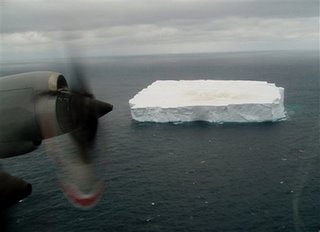Icebergs near NZ...still drifting
 Sun Nov 5, 6:43 PM ET
Sun Nov 5, 6:43 PM ET In this undated photo released by the New Zealand Defense Force, an iceberg is observed from a New Zealand Air Force P3 Orion maritime surveillance airplane on routine fisheries patrol in the southern ocean.
A maritime warning has been issued after approximately 100 icebergs were discovered near Auckland Islands, 260 kilometers (160 miles) south of the South Island of New Zealand Friday, Nov. 3, 2006. The largest iceberg about 2 kilometers by 1.5 kilometers (1.2 by 0.9 miles) and more than 130 meters (425 feet) high were found floating in a major ocean shipping lane.
(AP Photo/New Zealand Defense Force,HO)
Icebergs near NZ after drifting from Atlantic
Wed Nov 8, 5:53 AM ET
Scores of icebergs have floated to within about 300 km (186 miles) of New Zealand, with the largest measuring about 1.8 km (1.1 miles) in length and standing some 120 meters (360 feet) above water.
National Institute of Water and Atmospheric Research oceanographer Mike Williams said on Wednesday the icebergs were likely part of a larger piece of ice which broke off the Ronne Ice Shelf, located southeast of the Falkland Islands, six years ago.
The original iceberg, named A-43, was 167 km (104 miles) long 32 km (20 miles) wide.
Williams said about 100 icebergs, first detected by New Zealand's air force on Friday, had drifted eastward, south of Africa and Australia, in the dominant Antarctic Circumpolar Current.
"It's a natural but a rare phenomenon. It requires a lot of rare occurrences to happen simultaneously," he said.
"This iceberg has to have managed to make it to the right place in the main currents in the Southern Ocean to have gotten all the way around to New Zealand without melting.
"Then, it has to have moved far enough north to have got pushed up toward New Zealand rather than pushed further south which is what happens to most icebergs."
Williams said large icebergs break off Antarctica every 50 or 60 years.
"I don't we think can specifically say this iceberg is linked to global warming," he added.
About 90 percent of an iceberg is under water so it is unlikely that bigger icebergs would reach the shallow coasts of New Zealand, said Williams, adding ships traveling through the area should exercise caution.
The icebergs lie south of Invercargill on New Zealand's south island.
Copyright © 2006 Reuters Limited.
Comments